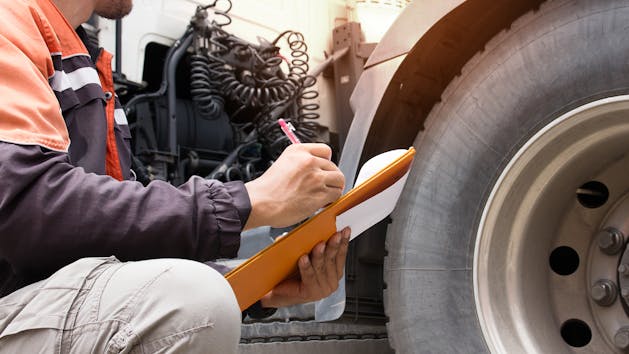Find the right solution for your business with our free Fleet Management Buyer’s Guide.
Get Your Fleet Ready for ELD 2.0
Though there are carriers taking advantage of the ELD mandate 2-year extension, which gives fleets until December of this year to comply, the majority of carriers have already installed ELD technology in their vehicles. And the good news is that ELDs have already made positive progress toward eliminating human error: hours of service (HOS) violations have significantly dropped1 and 51% of fleet owners say their CSA scores improved after becoming ELD-compliant.2
But for those who’ve already rolled out compliant ELD devices, there’s more work to be done. The very existence of ELD technology is changing the enforcement environment landscape, impacting what inspectors look for and creating a new breed of service violations for which a carrier can be fined.
Prepare for the rise of new violations
With a drop in 8-hour, 11-hour and 14-hour rule violations, we’re seeing that electronic onboard recording device technology is doing precisely what it was intended to do – replace human subjectivity and reduce the chance for human error.
The impact of fewer HOS violations citations translates to inspectors now having more time to scrutinize other devices, vehicle and carrier violations (some of which haven’t existed before). this means it’s important for drivers and business owners to be prepared to see an uptick in ELD solution-specific violations (for non-compliance), or to see inspectors focus more on new technology-related violations that are more applicable to the carrier than the driver.
To help stave off the possibility of a citation for newer violations, be sure that all staff – auditing, back office, drivers, fleet managers, etc. – understand the new regulations and the ELD device itself (including whether it’s registered, how it works and what drivers are required to possess in order to show compliance).
To learn exactly what to look for, here’s a list of some of the newer violations that could add cost and time to operations in 2019 and beyond:
- Operating with a device not registered with FMCSA
- Driver failed to maintain supply of blank log graph-grids
- Driver failed to maintain ELD instruction sheet
- Driver failed to maintain ELD user’s manual
- ELD cannot transfer ELD records electronically
- Portable ELD not mounted in a fixed position and visible to driver
- Failed to maintain instruction sheet for ELD malfunction reporting requirements
- Driver failed to manually add shipping document number
- Driver not adequately trained in operation of automatic onboard recording device
- Driver failed to use automatic on-board recording device when required by motor carrier
- Failed to note malfunction which requires use of paper log
- Driver failed to certify accuracy of information gathered by the ELD
- Driver failed to manually add the trailer number
Turn your attention to productivity and preventative maintenance
There’s every indication that the growth in violations tied to the new tech-based compliance environment will continue. And though technology-based mandates are likely to increase, it’s not all bad news. In fact, with HOS violations on the decline, it’s the perfect opportunity for forward-thinking carriers to shift their focus to other compliance technology that can help boost productivity and minimize costs.
Streamline efficiency
Electronic processes make it possible for existing employees to accomplish more (e.g. one person doing the work of ten in terms of reviewing reports and violations) and for companies as a whole to achieve more accurate billing and payroll. In addition, ELDs can help improve driver efficiency and route navigation precision (especially for first mile and last mile, which notoriously incur the most costs).
Control costs
Greater efficiency = greater profit. Leveraging technology like ELDs to limit driving time violations, unscheduled maintenance or manual paperwork is integral to controlling costs and achieving a more predictable revenue cycle. In fact, the FMCSA estimates that having the right ELD solution onboard can help save an estimated $705 per driver per year in paperwork alone.3
Future success (and violations) hinge on your ELD provider
Whether you’ve already invested in ELD technology, or are holding off until the end of 2019, the provider you choose can greatly impact whether or not you’re cited for violations. Consider this: in 2018, the 2nd most cited violation (more than 35,000) was for “operating with a device that is not registered with FMCSA.”1
Given that it’s fundamental for an ELD provider to register their ELD solution, this is a telling statistic. It demonstrates that not all ELD providers are being as forthcoming as they should be with the fleets they’re serving, and it shows that not every ELD solution on the market is actually in compliance with the ELD mandate.
Carriers and fleet managers must be diligent in vetting ELD providers and realize that, though cost is an important factor, the least expensive option isn’t necessarily the least “costly” choice if it ends up earning you fines. So, if you’re a carrier still looking for an ELD provider, or if it turns out your existing provider is non-compliant, here are some features to look for to help you select the solution that’s best for your fleet:
- Absolute compliance and coverage for a range of mandates including ELD/HOS, DVIRs and IFTA
- Automated data collection that helps drivers stay legal via an easy-to-use mobile platform
- The ability to reduce the paperwork burden for your drivers, speed up roadside inspections and keep central databases accurate and up-to-date
- Advanced training and support for both drivers and back office to ensure you are becoming an expert in your solution
- A solution that’s part of a larger platform (driver behavior monitoring, onboard inspection, etc.)
Looking ahead
For carriers and fleet-based operations, the compliance landscape is evolving. ELDs and other technologies will play a more vital role in safety, productivity and efficiency initiatives going forward, and will also have a greater impact on what – and how many – violations are given out by inspectors.
Carriers must be ready for the new breed of citations and must also be ready for other industry changes that will influence operations in 2019 and beyond. That’s why now’s the time to get ahead of the curve and maximize the value of the technology capabilities already integrated into vehicles by the manufacturer (navigation, routing, diagnostics, preventive maintenance, and ELD).
Learn more how bundling ELD with a telematics solution can help you streamline your business amidst the changing violations landscape with our free ebook, 7 Benefits of Bundling ELD & Fleet Tracking Solutions.
Sources
2https://www.freightwaves.com/news/2018/7/7/coretexreleases-post-mandate-eld-satisfaction-survey-results
3 https://www.federalregister.gov/documents/2014/03/28/2014-05827/electronic-logging-devices-and-hours-of-service-supporting-documents
Find out how our platform gives you the visibility you need to get more done.




